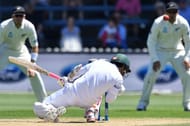Tamim Iqbal slashed the third ball of the day over the slip cordon for four and set the tempo of the Bangladesh innings. Under the dark sky and on a greenish deck, he flexed his muscles to disturb the length of New Zealand bowlers. Tamim’s confident strokeplay became contagious as Mominul Haque joined the party and executed some exquisite strokes off his fluid wrists.
On a sun-kissed day 2, Shakib Al Hasan and Mushfiqur Rahim unleashed one of the finest moments in the history of Bangladesh cricket by stitching a record partnership for the fifth wicket as the bowling of New Zealand was made to sweat on a hot day.
Bangladesh declared the first innings at 595 for 8, but still failed to create pressure on the hosts. And on day 5, they left the field dejected and disappointed as Kane Williamson and his men notched up an emphatic win against the Tigers to add more fuel to their woes.
It’s never acceptable to lose a Test after notching up so many runs in the first innings, but the reality is a harsh one and there were obvious reasons which contributed to such a defeat.
Inexperienced bowling attack
Bangladesh took the field without Mushfiqur Rahim as he was injured and Tamim was in charge. As a captain, Tamim was bold and his intent was to take wickets. But his aggressive intent was undermined by some poor bowling.
Taskin Ahmed and Mehedi Hasan Miraz were the weakest link of the Bangladesh bowling attack. While Kamrul Islam Rabbi, Shakib Al Hasan and Subashis Roy created pressure at one end, Taskin and Miraz released it and gave the home team the opportunity to settle down with ease.
The two were too short and struggled to understand the ideal length to be bowled in that pitch. Mehedi’s pace was his major weapon to nail the English batting line-up last year, but at Wellington, his deliveries lacked pace and the cutting edge as he didn’t use his shoulder enough. Of course, relying too much on the shoulder is not good, but Mehedi needs to add guile to his game.
Also Read: Shakib Al Hasan reveals what motivated him to the record-breaking knock in Wellington
The track, vastly different from the tracks in Dhaka and Chittagong, was not aiding enough turn and bounce even on day 3. Mehedi needed to concentrate on discipline and make the batsman play forward rather than trying to be too adventurous.
Even though Taskin has been one of the major reasons behind Bangladesh’s outstanding success in the limited-overs format, in Tests, he has never seemed to be up to the mark. Pitching the ball on a 50 or 20-over format length and dragging the ball way too short are never ideal on wickets like Wellington.
A pace bowler needs to understand the flow of the breeze and utilise it at its very best by pitching the ball full enough in-and-around the off stump to gain maximum results.
Taskin bowling was suited for a limited-overs game and thus gave away 141 runs from 29 overs in the first innings.
Meanwhile, Subashis’ problems with the landing of his front foot dented his rhythm and Tamim found the going tough on the field.
Above all, one needs to bear in mind, this bowling attack was inexperienced. Taskin and Subashis were making their debuts while Mehedi and Rabbi were playing their third Test. The responsibility on Shakib was huge, but it is quite obvious that he cannot strike gold every day and thus, the inexperience of others, left Bangladesh struggling.
Lack of mental strength, skill and fitness to counter the short-ball attack
One of the major reasons behind New Zealand’s success at home has been their ability to trigger collapses in the second innings by unleashing a ferocious display of short-ball bowling. Neither Tim Southee nor Trent Boult are known for their short-pitch bowling, but Neil Wagner has played a vital role in creating unrelenting pressure on the opposition and triggering collapses.
Wagner’s short-balls are different; he bangs the ball short by targeting the rib cage area of a batsman at a deceptive pace with an astonishing regularity. This tactic has helped New Zealand come back in the game many times in the past and it was no different at Wellington.
Be it with the wind or against the wind, Wagner did not shy from throwing cannon balls from his disposal and intimidate the batsman.
To counter such bowling, a batsman needs to be mentally tough and technically solid. Mental toughness is especially important against the short-ball attacks.
The flurry of short-ball attacks were expected on the final day and Wagner hinted at such a tactic at the fag end of day 4. But the Bangladesh batsmen lacked the mental strength and physical fitness to withstand the heat of Wagner and co.
Even technically, the Bangladeshi batsmen were not well-equipped against the short-ball attack.
Also Read: Substitute Bangladesh wicket-keeper Imrul Kayes sets new world record
They are not trained to get on top of the bounce, on the back foot quickly and behind the line of the ball against short-balls. When the initial trigger movement is on the front foot, it’s never easy to play the short-balls well. Had the initial trigger movement of Bangladesh batsmen been on the back foot, it would have been easier to negotiate the short stuff
The Bangladeshi batting line-up melted and squandered a great opportunity of getting a positive result.
Brand-new app in a brand-new avatar! Download CricRocket for fast cricket scores, rocket flicks, super notifications and much more! 🚀☄️

